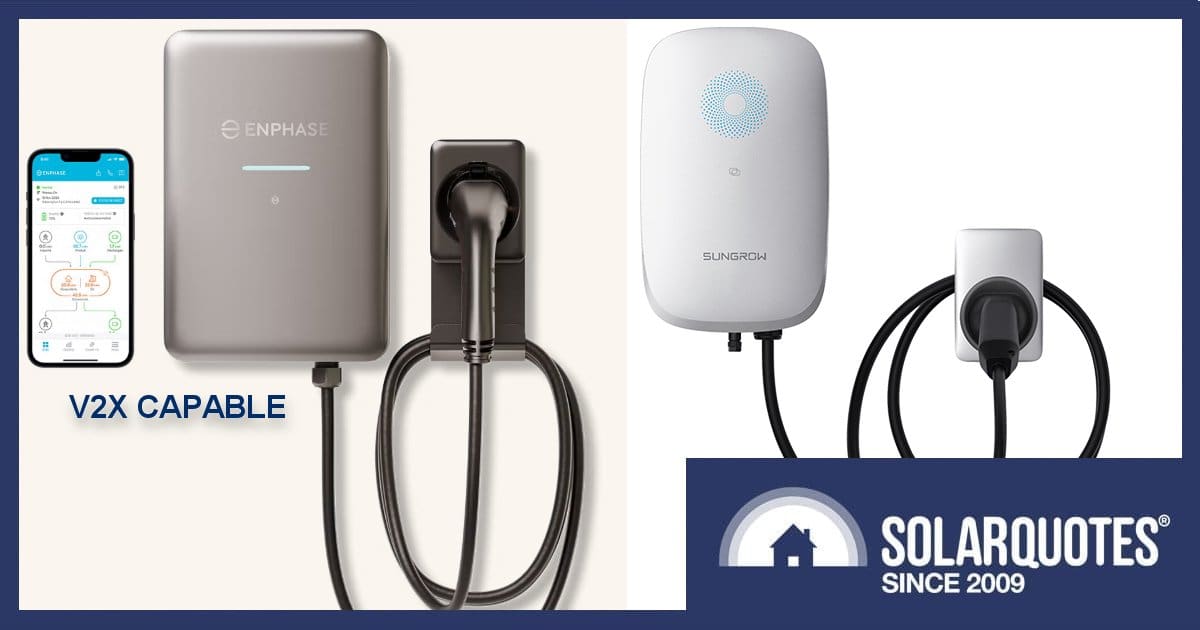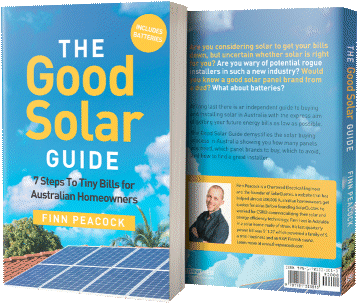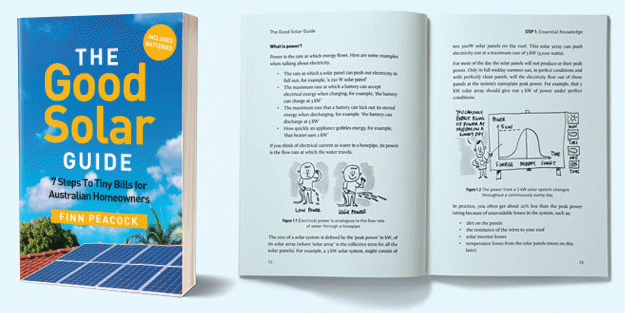
It shouldn’t be long before the new Sungrow EV charger will reach our shores and the “V2X-capable” Enphase IQ 2 won’t be far behind it. Here’s a taste of what’s to come and (approximately) when.
Enphase IQ EV Charger 2: Sort Of V2X Ready
Australia missed out on the original IQ EV Charger, but we should be seeing the IQ EV Charger 2 towards the end of June according to Enphase Energy.
This device supports charging up to 22 kW on a three-phase connection and 7.4 kW on single-phase, and it has automatic phase shifting. It helps maximise solar charging by having a low threshold (1.4kW) and tracking surplus solar power every 30 seconds; regulating charging current in 1 A increments. Enphase notes these features are “available for select site configurations” and the data sheet states:
“When integrated with Enphase PV or any other PV system (through IQ Gateway)”.
The datasheet also notes OCPP 2.0.1 support, dynamic load balancing and user-configurable custom or off-peak charging schedules.
The IQ EV Charger 2 is IP55-rated, meaning it can be installed in outdoor or indoor environments, and has an ambient operating temperature range of -40°C to 55°C. This is a tethered device that comes with a 7.5 metre cable with a Type 2 connector, and a nice touch is the cable and connector holster.
Its dimensions are 370 mm × 250 mm × 118 mm and the device weighs 11kg, but that’s including the cable.
Monitoring and control of charging is carried out with the Enphase App.
A stand-out feature is the warranty, which is 5 years. Most manufacturers only offer 2 – 4 years.
V2X Capable … But Locked
V2X stands for Vehicle To Everything. V2X encompasses a wide range of capabilities involving bi-directional communication and energy transfer, including Vehicle To Grid (V2G), Vehicle To Home (V2H) and Vehicle To Load (V2L). You can learn more about V2G, V2H and V2L here.
Enphase says the IQ EV Charger is V2X-ready but software-locked for now and further details of these capabilities aren’t yet available.
As for the cost of this charger – on the Australian Enphase site it’s priced at $2,048, which makes it the most expensive device we list on the SolarQuotes home EV charger comparison table. It’s not clear if the V2X unlocking, when available, will involve an extra cost.
You can learn more about the IQ EV Charger 2 here.
Sungrow AC22E-01: Half-Baked?
Sungrow’s first EV charging devices for home use were the AC007E-01 (single-phase 7kW) and the AC011E-01 (three-phase 11kW), initially released in 2022. While a couple of Australian vendors list the AC011E-01 (but none I could find listing the AC007E-01), all show it being out of stock. I’m unsure if it has ever been available here.
What we’re told will be here late this month or early June is the Sungrow AC22E-01. This device offers 22 kW or 11 kW charging on a three-phase connection and up to 7.4kW on single phase.
It has solar smart charging features along with other charging modes and load management and balancing capabilities. But at this point, these advanced features are reportedly only supported when paired with Sungrow hybrid inverters via iSolarCloud, the company’s monitoring system. The AC22E-01 has OCPP 1.6 support.
This is also a tethered device, with a 5-metre cable standard or an optional 7 metres and it looks to come with a holster as well. The AC22E-01 is IP65-rated, has an operating ambient temperature range of -30°C to 50°C, dimensions of 214 mm x 346 mm x 125 mm and a weight of 6.65 kilograms (without the cable).
I’ve read the AC22E-01 has a warranty of 3 years, but I’m yet to see an Australian warranty document. No word on estimated retail pricing yet. We’ll have this charger listed on the comparison chart in the not-too-distant future as well, and more on the Sungrow AC22E-01 can be found here.
Australian EV owners have a wide range of charging device choices these days and it can be confusing figuring out which may be the most suitable solution. This is where SolarQuotes founder Finn’s home EV charging guide can help. The guide will tell you everything you need to know about choosing a device, side-by-side comparisons on specs and estimated pricing of a bunch of models, and the brands SolarQuotes currently recommends.

 RSS - Posts
RSS - Posts



I was watching the sungrow EVSE with great interest from the day they were first advertised. They have never been released into Australia and Sungrow stated to me there were no official wholesales or resellers in Australia as of about a year ago. It was suspected that one of the websites ‘selling’ them was a scam page, but they couldn’t do anything about it. I have since given up waiting and bought a different random Chinese brand which is so far doing the job, but its solar tracking is sub optimal. i was looking for the sungrow charger to attach to my existing sungrow solar.
Am I right to think that the V2X facility on the Enphase equipment is only going to support the AC inverter on the vehicle (ie. via the V2L functionality – ie. limited by vehicle inverter capacity (typically 2 to 3kW)?
I thought this because the cable isn’t CCS2.
Hi AR,
Direct from Enphase Australia
“The IQ EV Charger 2 being an AC bi-directional charger, the V2X performance will be according to the discharge rate of the EV. Some of the newer ISO-15118 compatible cars have explicitly published bi-directional charging of up-to 11kW. Since the IQ EV Charger 2 also supports charging communication in accordance with ISO 15118 and is equipped with appropriate power electronics capable of handling bidirectional power flow, it will support both Vehicle-to-Home (V2H) and Vehicle-to-Grid (V2G) functionalities accordingly (once the necessary firmware update is available)”
Additionally, a separate DC Bi-Directional charger is being developed by Enphase, details of which can be found here https://enphase.com/ev-chargers/bidirectional.
2k for the enphase dc v2x charger seems cheap. I believe the sigenergy one is like 6k no?
Hi Alex,
Reply straight from Enphase themselves, the difference is that the Enphase AC solution uses the car’s on board inverter :
“While there is a separate DC bi-directional EV Charger being developed by Enphase, IQ EV Charger 2 which is currently available, is hardware ready for AC bi-directional. This charger is capable of supporting V2G, V2H when configured with necessary interconnect devices like IQ system controller or compatible IQ relay along with the associated firmware once available. For more information on Enphase’s upcoming DC bidirectional EV charger refer to: https://enphase.com/ev-chargers/bidirectional.”
Although I’m stuck with my dumb Tesla WC3, I’ve read that Sungrow ev chargers are able to switch between 1 phase to 3 phase during solar charging. This means it would be possible to track yiur excess solar from 1 phase 6A (1440W) up to 3 phase 16/32A (11/22kW) in 1 Amp increments.
For my next EV, I want a reasonably priced V2G ac charger, that is OCPP (preferably ver2). & compatible with Home Assistant. It would be great if it was reasonably priced too (ZJBeny are you listening??)
The Enohase IQ EV Charger 2 has a Type 2 connector only, not a CCS2 connection so there are no vehicles on the market that could work with the purported V2X capability, certainly not when X is Grid.
Remember, if you can’t have it now then the feature does not exist.
https://www.acsolarwarehouse.com/web/content/370410
Looks like this EV Charger 2 doesn’t come with inbuilt inverter, so I suspect bi-directional charging would need to rely on triggering V2L feature of vehicle via the Type 2 connector.
Guessing that the current V2X “locked for now” feature is the resistor circuitry to turn the V2L on (will need to support many resistor values given that the V2L resistor varies between car brands). Each vehicle would have different maximum load that needs to be taken into consideration.
Wired back as into some future feature into the Enphase controller to be able to support both charging and V2L supply, and this would be the certified equipment rather than the EV – sounds like another piece of hardware and rewiring based on current install guideline.
About time for SunGrow to get a charger to match their systems. I have been waiting a long time for this moment to arrive. I will be able to plug the communication cable into the inverter and only use the one app. And I’m sure it will work like a Tesla set up with Amber.
We have a Sungrow SG10RT inverter, which is not the hybrid version. Seems odd that they only support their hybrid inverters with the smart features. I was really hoping to be able to charge with excess solar without having to rely on Charge HQ to do it.
Thanks Anthony, I guess now is probably the time to push our EV brand to support ISO 15118 – hopefully for our BYD vehicle just a software update given the vehicle already supports AC V2L via the simple passive plug resistor method. Otherwise it’ll be back to the more expensive DC V2H inverters that are still to be released or looking for ways to have V2L being a dumb battery solar battery charger. It’s looking hard to plot a sensible path through this without going down dead-ends. Perhaps for now just a smaller home battery that meets most needs is the most sensible path (after battery competition kicks in and pushes the current high prices down).
I spoke to Sungrow and they are expecting the AC22E-01 EV charger to be released in the 3rd quarter of the year.
Available now online from UV Power
Excellent. I’ll let my installer in NQ know.
I’ve installed the Sungrow. DON’T DO IT! My installer and I are pulling our hair out because it does not do scheduled charging when it was advertised. The ihomemanager overrides the inverter so 90% of the apps functionality stops working. On addition, the communication module keeps dropping out. It’s pretty much a disaster! My installer got to the most senior guy at Sungrow who validated my concerns and admitted they released the product into Australia untested and with functionality turned off. The communication and support from Sungrow has been non existence. I’m making a complaint to the ACCC and Consumer Affairs Victoria.